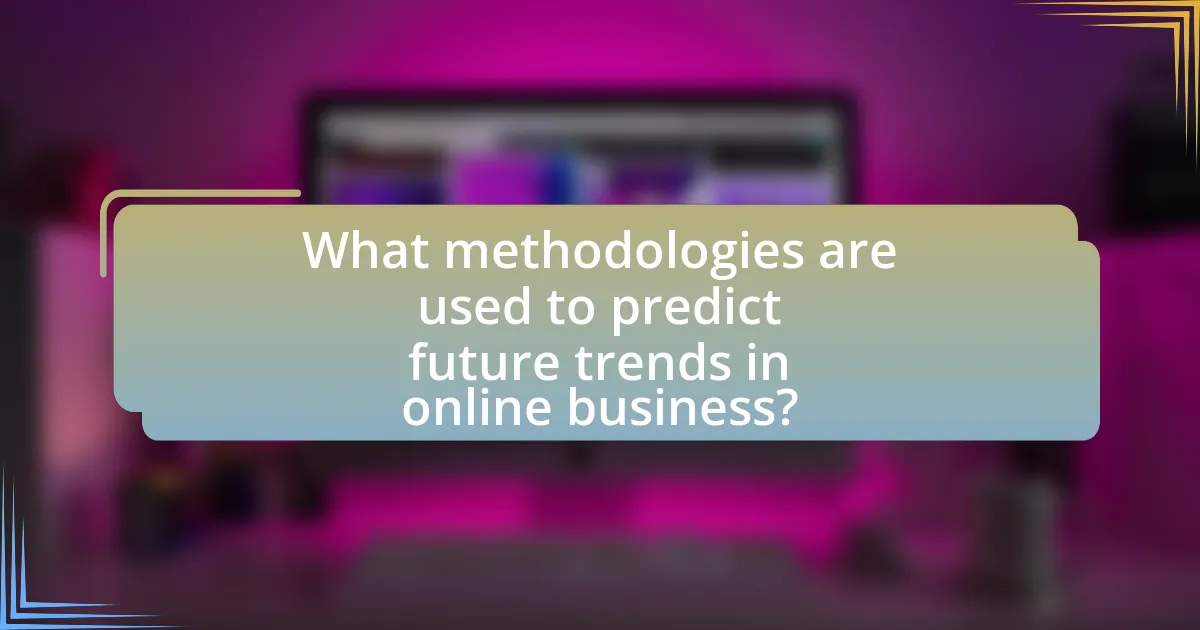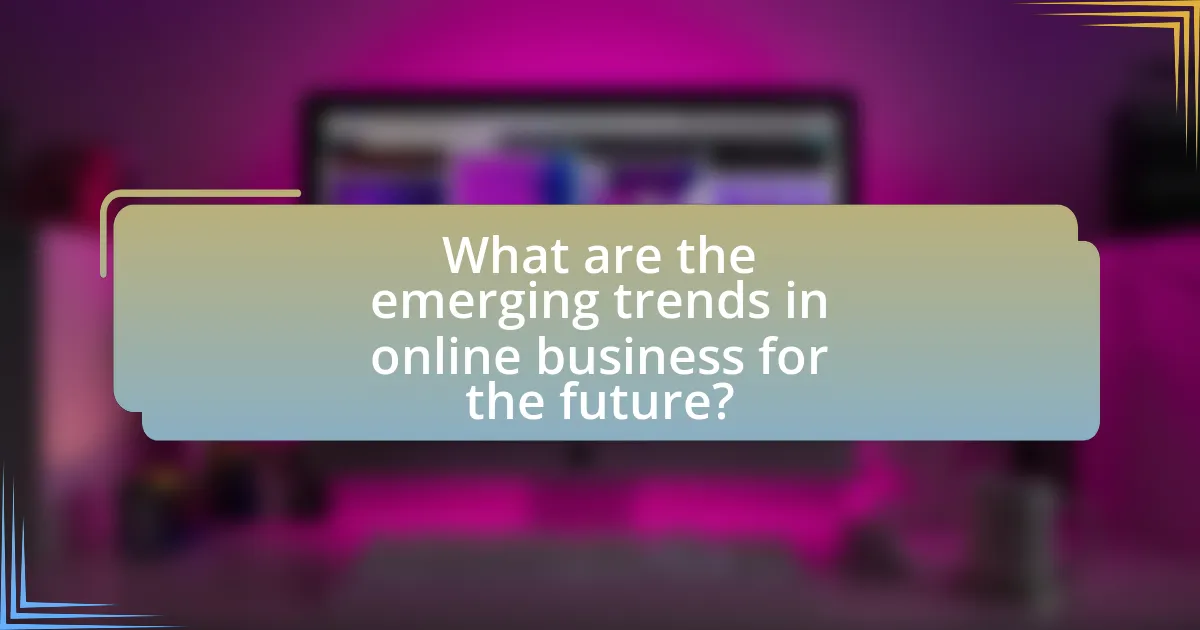The article focuses on predicting future trends in online business through data-driven insights. It examines key factors such as technological advancements, shifts in consumer behavior, and regulatory changes that shape the online marketplace. The discussion includes the impact of mobile shopping, the role of artificial intelligence and machine learning in trend analysis, and the importance of data analytics for forecasting. Additionally, it highlights emerging consumer preferences, sustainability trends, and the influence of social media and personalization on online shopping experiences. The article emphasizes the necessity for businesses to adapt their strategies based on these insights to remain competitive in a rapidly evolving digital landscape.

What are the key factors influencing future trends in online business?
The key factors influencing future trends in online business include technological advancements, consumer behavior shifts, and regulatory changes. Technological advancements, such as artificial intelligence and blockchain, are reshaping how businesses operate and interact with customers, enhancing efficiency and security. Consumer behavior shifts, driven by increased digital engagement and demand for personalized experiences, are prompting businesses to adapt their strategies to meet evolving expectations. Regulatory changes, particularly concerning data privacy and e-commerce laws, are also influencing how online businesses must operate to remain compliant and competitive. For instance, the implementation of the General Data Protection Regulation (GDPR) in Europe has significantly impacted how companies handle consumer data, necessitating changes in business practices.
How do consumer behaviors shape online business trends?
Consumer behaviors significantly shape online business trends by influencing purchasing patterns, preferences, and engagement strategies. For instance, the rise of mobile shopping has led businesses to optimize their websites for mobile devices, reflecting consumer demand for convenience and accessibility. According to a report by Statista, mobile e-commerce accounted for 54% of total e-commerce sales in 2021, highlighting the necessity for businesses to adapt to consumer preferences. Additionally, the increasing emphasis on sustainability has prompted companies to adopt eco-friendly practices, as 66% of global consumers are willing to pay more for sustainable brands, according to a Nielsen study. This shift in consumer values drives businesses to innovate and align their offerings with these emerging trends, ultimately shaping the landscape of online commerce.
What specific consumer preferences are emerging in the digital marketplace?
Emerging consumer preferences in the digital marketplace include a strong demand for personalized experiences, sustainability, and convenience. Consumers increasingly favor tailored recommendations based on their browsing and purchasing history, as evidenced by a McKinsey report indicating that 71% of consumers expect companies to deliver personalized interactions. Additionally, there is a growing preference for sustainable products, with a Nielsen study showing that 73% of millennials are willing to pay more for sustainable offerings. Finally, convenience remains paramount, with a Statista survey revealing that 79% of consumers prioritize fast and easy online shopping experiences.
How does the shift to mobile impact online shopping trends?
The shift to mobile significantly enhances online shopping trends by increasing accessibility and convenience for consumers. Mobile devices account for over 50% of global e-commerce traffic, as reported by Statista in 2023, indicating a strong preference for shopping via smartphones and tablets. This trend leads to higher conversion rates, as mobile-optimized websites and apps streamline the purchasing process, reducing friction for users. Additionally, mobile shopping facilitates personalized marketing through location-based services and targeted advertisements, further driving sales. The integration of mobile payment options, such as digital wallets, also contributes to a seamless shopping experience, encouraging more frequent purchases.
What role does technology play in predicting online business trends?
Technology plays a crucial role in predicting online business trends by enabling data analysis and forecasting through advanced algorithms and machine learning. These technologies process vast amounts of data from various sources, such as consumer behavior, market dynamics, and social media interactions, to identify patterns and trends. For instance, predictive analytics tools can analyze historical sales data to forecast future demand, allowing businesses to optimize inventory and marketing strategies. According to a report by McKinsey & Company, companies that leverage data-driven decision-making are 23 times more likely to acquire customers and 6 times more likely to retain them, highlighting the effectiveness of technology in trend prediction.
How do advancements in AI and machine learning affect trend analysis?
Advancements in AI and machine learning significantly enhance trend analysis by enabling more accurate predictions and insights from large datasets. These technologies utilize algorithms that can identify patterns and correlations in data that traditional methods may overlook, leading to improved forecasting accuracy. For instance, machine learning models can analyze historical sales data, customer behavior, and market conditions to predict future trends with greater precision. A study by McKinsey & Company found that companies using advanced analytics are 23 times more likely to acquire customers and 6 times more likely to retain them, demonstrating the effectiveness of AI-driven trend analysis in driving business success.
What technologies are essential for data-driven insights in online business?
Essential technologies for data-driven insights in online business include data analytics platforms, machine learning algorithms, and cloud computing services. Data analytics platforms, such as Google Analytics and Tableau, enable businesses to collect, analyze, and visualize data effectively, providing actionable insights into customer behavior and market trends. Machine learning algorithms, like those used in predictive analytics, allow businesses to identify patterns and forecast future trends based on historical data. Cloud computing services, such as AWS and Microsoft Azure, facilitate scalable data storage and processing, enabling businesses to handle large datasets efficiently. These technologies collectively empower online businesses to make informed decisions and enhance their strategic planning.
Why is data analysis crucial for forecasting online business trends?
Data analysis is crucial for forecasting online business trends because it enables businesses to identify patterns and make informed predictions based on historical data. By analyzing metrics such as customer behavior, sales figures, and market conditions, companies can anticipate future trends and adjust their strategies accordingly. For instance, a study by McKinsey & Company found that organizations that leverage data analytics effectively can improve their decision-making processes by 5 to 6 times, leading to better forecasting accuracy and enhanced competitive advantage. This reliance on data-driven insights allows businesses to respond proactively to market changes, optimize operations, and ultimately drive growth.
What types of data are most valuable for predicting trends?
Quantitative data, such as sales figures, customer demographics, and website traffic metrics, are most valuable for predicting trends. These data types provide measurable insights that can be analyzed statistically to identify patterns and forecast future behaviors. For instance, a study by McKinsey & Company found that companies leveraging data analytics to understand customer behavior can increase their profitability by 15-20%. Additionally, qualitative data, including customer feedback and social media sentiment, complements quantitative data by providing context and deeper understanding of consumer preferences. Together, these data types enable businesses to make informed decisions and anticipate market shifts effectively.
How can businesses effectively collect and analyze data?
Businesses can effectively collect and analyze data by implementing structured data collection methods and utilizing advanced analytical tools. Structured methods include surveys, customer feedback forms, and web analytics, which provide quantitative data that can be easily analyzed. Advanced analytical tools, such as machine learning algorithms and data visualization software, enable businesses to identify patterns and trends in the data. For instance, according to a report by McKinsey, companies that leverage data analytics can improve their operational efficiency by 20-30%. This demonstrates that effective data collection and analysis not only enhance decision-making but also drive significant business performance improvements.

What methodologies are used to predict future trends in online business?
Methodologies used to predict future trends in online business include data analytics, machine learning, and market research. Data analytics involves analyzing historical data to identify patterns and trends, which can inform future business strategies. Machine learning algorithms can process large datasets to make predictions based on identified trends, enhancing accuracy over traditional methods. Market research, including surveys and focus groups, provides qualitative insights into consumer behavior and preferences, which can also guide predictions. These methodologies are validated by their widespread application in successful online businesses, demonstrating their effectiveness in trend forecasting.
How do qualitative and quantitative methods differ in trend prediction?
Qualitative and quantitative methods differ in trend prediction primarily in their approach to data analysis. Qualitative methods focus on subjective insights, exploring underlying motivations and behaviors through interviews, focus groups, and open-ended surveys, which provide rich, contextual information. In contrast, quantitative methods rely on numerical data and statistical analysis, utilizing structured surveys, experiments, and existing datasets to identify patterns and trends through measurable metrics. For instance, a study by Creswell (2014) highlights that qualitative research can uncover consumer sentiments that numbers alone may not reveal, while quantitative research can validate these insights with statistical significance, demonstrating the complementary nature of both approaches in effective trend prediction.
What are the strengths and weaknesses of qualitative analysis?
Qualitative analysis has strengths and weaknesses that significantly impact its application in research. The strengths include its ability to provide in-depth insights into complex phenomena, capturing the richness of human experience and context, which quantitative methods may overlook. For instance, qualitative analysis can reveal consumer motivations and behaviors through interviews or focus groups, offering nuanced understanding that aids in predicting future trends in online business.
Conversely, weaknesses of qualitative analysis involve its subjectivity and potential for researcher bias, which can affect the reliability and generalizability of findings. The lack of standardized measures makes it difficult to replicate studies or draw broad conclusions. Additionally, qualitative data can be time-consuming to analyze, limiting the speed at which insights can be derived. These factors can hinder the effectiveness of qualitative analysis in making data-driven decisions in a rapidly evolving online business landscape.
How can quantitative data enhance the accuracy of predictions?
Quantitative data enhances the accuracy of predictions by providing measurable and objective information that can be analyzed statistically. This data allows businesses to identify patterns, trends, and correlations that inform decision-making processes. For instance, a study by the McKinsey Global Institute found that companies using data-driven decision-making are 23 times more likely to acquire customers and 6 times more likely to retain them. By leveraging quantitative metrics such as sales figures, customer demographics, and market trends, businesses can create predictive models that yield more reliable forecasts, ultimately leading to improved strategic planning and resource allocation.
What role do market research and surveys play in trend forecasting?
Market research and surveys are essential tools in trend forecasting as they provide data-driven insights into consumer preferences and behaviors. By systematically collecting and analyzing information from target demographics, businesses can identify emerging trends and shifts in market demand. For instance, a study by Nielsen found that 63% of consumers prefer to buy from brands that align with their values, highlighting the importance of understanding consumer sentiment through surveys. This data enables companies to make informed decisions about product development, marketing strategies, and overall business direction, ensuring they remain competitive in a rapidly changing market.
How can businesses design effective surveys for trend analysis?
Businesses can design effective surveys for trend analysis by clearly defining their objectives, utilizing targeted questions, and ensuring a representative sample. Clearly defined objectives guide the survey’s focus, allowing businesses to gather relevant data that aligns with their goals. Targeted questions, including both quantitative and qualitative formats, help capture nuanced insights into customer preferences and behaviors. Additionally, ensuring a representative sample enhances the reliability of the findings, as it reflects the broader population’s views. Research indicates that surveys with well-structured questions and a diverse respondent pool yield more accurate trend predictions, as seen in studies conducted by the Pew Research Center, which emphasize the importance of methodological rigor in survey design.
What are the best practices for interpreting survey data?
The best practices for interpreting survey data include ensuring clarity in survey questions, analyzing data with appropriate statistical methods, and considering the context of the data. Clarity in questions helps reduce ambiguity, leading to more accurate responses. Utilizing statistical methods, such as regression analysis or factor analysis, allows for deeper insights into relationships and trends within the data. Additionally, understanding the context, including demographic factors and external influences, is crucial for accurate interpretation. For instance, a survey conducted during a specific economic downturn may yield different insights than one conducted in a stable economic environment, highlighting the importance of contextual awareness in data interpretation.
How can predictive analytics tools assist in trend forecasting?
Predictive analytics tools assist in trend forecasting by analyzing historical data to identify patterns and make data-driven predictions about future trends. These tools utilize statistical algorithms and machine learning techniques to process large datasets, enabling businesses to forecast customer behavior, market demands, and emerging trends with greater accuracy. For instance, a study by McKinsey & Company found that organizations using predictive analytics can improve their forecasting accuracy by up to 20%, leading to more informed decision-making and strategic planning.
What features should businesses look for in predictive analytics software?
Businesses should look for user-friendly interfaces, robust data integration capabilities, and advanced machine learning algorithms in predictive analytics software. User-friendly interfaces facilitate ease of use for non-technical staff, enabling broader adoption across the organization. Robust data integration capabilities ensure that the software can seamlessly connect with various data sources, such as CRM systems and databases, which is crucial for accurate predictions. Advanced machine learning algorithms enhance the software’s ability to analyze complex datasets and generate actionable insights, thereby improving decision-making processes. These features collectively empower businesses to leverage data effectively for forecasting and strategic planning.
How do predictive models improve decision-making in online business?
Predictive models enhance decision-making in online business by analyzing historical data to forecast future trends and behaviors. These models utilize algorithms that identify patterns in customer interactions, sales data, and market conditions, allowing businesses to make informed decisions regarding inventory management, marketing strategies, and customer engagement. For instance, a study by McKinsey & Company found that companies using predictive analytics can improve their marketing ROI by 15-20% by targeting the right audience with personalized offers. This data-driven approach enables businesses to allocate resources more efficiently and respond proactively to market changes, ultimately leading to increased profitability and customer satisfaction.

What are the emerging trends in online business for the future?
Emerging trends in online business for the future include increased adoption of artificial intelligence, personalization of customer experiences, and the rise of subscription-based models. Artificial intelligence is transforming customer service through chatbots and predictive analytics, enhancing efficiency and user satisfaction. Personalization is becoming crucial, with 80% of consumers more likely to make a purchase when brands offer personalized experiences. Subscription-based models are gaining traction, with the subscription e-commerce market projected to reach $478.2 billion by 2025, indicating a shift in consumer purchasing behavior towards convenience and value.
What impact will social media have on future online business trends?
Social media will significantly shape future online business trends by enhancing customer engagement and driving targeted marketing strategies. As of 2023, over 4.7 billion people use social media globally, providing businesses with vast audiences for personalized advertising. This trend is supported by data indicating that 73% of marketers believe that their efforts through social media marketing have been “somewhat effective” or “very effective” for their business. Furthermore, social media platforms are increasingly integrating e-commerce features, allowing businesses to sell directly through their channels, which is projected to grow the social commerce market to $1.2 trillion by 2025. This integration will lead to more seamless shopping experiences and increased sales opportunities for online businesses.
How are social commerce and influencer marketing evolving?
Social commerce and influencer marketing are evolving through increased integration of shopping features within social media platforms and a shift towards authentic, community-driven content. Social media platforms like Instagram and TikTok are enhancing their shopping capabilities, allowing users to purchase products directly through posts and stories, which streamlines the buying process. According to a report by eMarketer, social commerce sales in the U.S. are projected to reach $79.64 billion by 2025, indicating significant growth in this area. Influencer marketing is also adapting by focusing on micro and nano influencers, who often have higher engagement rates and foster more genuine connections with their audiences. A study by Influencer Marketing Hub found that 90% of marketers believe influencer marketing is effective, highlighting its continued relevance and evolution in the digital landscape.
What role does user-generated content play in shaping trends?
User-generated content significantly influences trend formation by providing authentic insights and fostering community engagement. This content, which includes reviews, social media posts, and videos created by consumers, serves as a reflection of public opinion and preferences. According to a study by Nielsen, 92% of consumers trust user-generated content more than traditional advertising, indicating its power in shaping purchasing decisions and brand perceptions. As a result, businesses that leverage user-generated content can better align their offerings with consumer desires, ultimately driving trends in the market.
How is personalization transforming the online shopping experience?
Personalization is transforming the online shopping experience by tailoring product recommendations and marketing messages to individual consumer preferences. This approach enhances customer engagement and satisfaction, leading to increased conversion rates. For instance, a study by McKinsey & Company found that personalized experiences can lead to a 10-30% increase in sales. Additionally, platforms like Amazon utilize algorithms that analyze user behavior to suggest products, significantly improving the likelihood of purchase. This data-driven personalization not only fosters loyalty but also drives repeat business, illustrating its critical role in shaping the future of online retail.
What technologies enable personalized marketing strategies?
Technologies that enable personalized marketing strategies include artificial intelligence, machine learning, customer relationship management (CRM) systems, data analytics platforms, and marketing automation tools. Artificial intelligence and machine learning analyze consumer behavior and preferences, allowing businesses to tailor their marketing efforts effectively. CRM systems store and manage customer data, facilitating personalized communication. Data analytics platforms provide insights into customer trends and segmentation, while marketing automation tools streamline the delivery of personalized content across various channels. These technologies collectively enhance the ability to engage customers with relevant and timely marketing messages, leading to improved customer satisfaction and increased sales.
How can businesses measure the effectiveness of personalization efforts?
Businesses can measure the effectiveness of personalization efforts through key performance indicators (KPIs) such as conversion rates, customer engagement metrics, and customer satisfaction scores. For instance, a study by McKinsey & Company found that personalized experiences can lead to a 10-30% increase in conversion rates. Additionally, tracking metrics like average order value and repeat purchase rates can provide insights into how personalization influences customer behavior. Analyzing customer feedback through surveys can also help gauge satisfaction levels with personalized offerings, further validating the impact of these efforts.
What are the implications of sustainability on online business trends?
Sustainability significantly influences online business trends by driving consumer preferences towards eco-friendly products and practices. As consumers increasingly prioritize environmental responsibility, businesses that adopt sustainable practices often experience enhanced brand loyalty and market differentiation. For instance, a 2021 survey by McKinsey found that 70% of consumers are willing to pay more for sustainable brands, indicating a clear market shift. Additionally, companies that implement sustainable supply chain practices can reduce costs and improve efficiency, as seen in the case of Unilever, which reported savings of over €1 billion through sustainable sourcing initiatives. Thus, the implications of sustainability on online business trends include increased consumer demand for eco-friendly options and operational efficiencies that can lead to competitive advantages.
How are consumer expectations regarding sustainability changing?
Consumer expectations regarding sustainability are increasingly demanding, with a significant shift towards prioritizing eco-friendly practices in purchasing decisions. Recent studies indicate that 66% of global consumers are willing to pay more for sustainable brands, reflecting a growing awareness of environmental issues and a desire for corporate responsibility. Additionally, 81% of millennials expect companies to be environmentally responsible, showcasing a generational trend that emphasizes sustainability as a key factor in brand loyalty. This evolution in consumer behavior is driving businesses to adopt more sustainable practices, as failure to meet these expectations can result in loss of market share and consumer trust.
What strategies can businesses adopt to align with sustainability trends?
Businesses can adopt strategies such as implementing circular economy practices, enhancing energy efficiency, and prioritizing sustainable sourcing to align with sustainability trends. Circular economy practices involve designing products for longevity and recyclability, which reduces waste and resource consumption. Enhancing energy efficiency can be achieved through the adoption of renewable energy sources and energy-efficient technologies, leading to lower operational costs and reduced carbon footprints. Prioritizing sustainable sourcing means selecting suppliers who adhere to environmentally friendly practices, which can improve brand reputation and customer loyalty. According to a 2021 McKinsey report, companies that actively engage in sustainability can see a 20% increase in customer loyalty and a 15% increase in employee satisfaction, demonstrating the tangible benefits of these strategies.
What practical steps can businesses take to leverage data-driven insights for future trends?
Businesses can leverage data-driven insights for future trends by implementing advanced analytics tools to analyze customer behavior and market patterns. By utilizing tools such as predictive analytics and machine learning algorithms, companies can identify emerging trends and consumer preferences based on historical data. For instance, a study by McKinsey & Company found that organizations using data analytics effectively can improve their decision-making processes by 5 to 6 times, leading to better alignment with market demands. Additionally, businesses should invest in data visualization techniques to present insights clearly, enabling stakeholders to make informed decisions quickly. Regularly updating data sources and integrating real-time analytics can further enhance the accuracy of trend predictions, ensuring that businesses remain competitive in a rapidly changing market.





